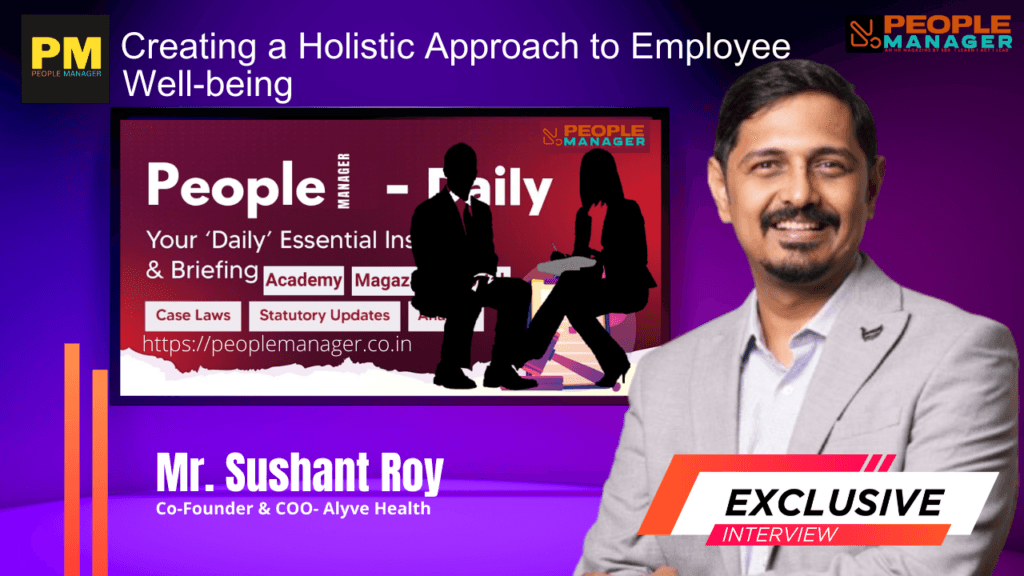Sushant Roy on- Creating a Holistic Approach to Employee Well-being
Adopting a holistic approach to employee well-being that integrates mental and physical health, promoting work-life balance, and focusing on overall employee well-being are essential for fostering a thriving workplace. - Sushant Roy, Co-founder & COO of Alyve Health

In a recent enlightening discussion, Sushant Roy, co-founder of Alyve Health, a platform that helps employers create holistic well-being programs, shared his insights on the importance of implementing holistic well-being programs in the workplace. This comprehensive approach addresses various aspects of health, ensuring that employees feel supported in their mental, physical, emotional, social, and financial well-being.
Mr. Roy emphasized that a successful holistic well-being program must cater to the diverse needs of individuals and their families. These programs should encompass all facets of health, ensuring a comprehensive approach to employee well-being. Organizations must foster a supportive environment that prioritizes mental health and proactive well-being initiatives.
One of the key strategies discussed was the importance of offering customizable health plans. Mr. Roy noted that flexibility in health plans can significantly enhance employee engagement. Programs could include options like quitting smoking, yoga classes, and comprehensive sleep programs.
Utilizing real-time data and health insights is crucial for developing personalized health initiatives. Mr. Roy highlighted how data-driven insights can lead to more effective and targeted well-being strategies.
The discussion concluded with a powerful message on the necessity of adopting a holistic approach to employee well-being. Integrating mental and physical health, promoting work-life balance, and focusing on overall employee well-being are essential for fostering a thriving workplace.
By implementing these strategies, organizations can create a culture of well-being that supports the diverse needs of their workforce, ultimately leading to a healthier and more productive environment.
Watch full- Interview: How to Create a Holistic Approach to Employee Well-Being: Key Points and Discussions
BIR R Sanghvi : Can you begin by explaining your understanding of holistic approaches to employee well-being? What actions can organizations take in today’s workplace?
Sushant Roy: Well-being has to be looked at from different perspectives.
- Addressing all aspects of health is key. This means focusing on physical, mental, emotional, social, and financial well-being.
- We also need to consider that a person’s well-being is impacted by the well-being of their family members such as children, spouses, and parents. It’s all interconnected.
- It’s not just about treating illnesses. We need to think about prevention and assessment as well.
- We need to recognize the uniqueness of each individual. Everyone has different motivations and health challenges.
BIR R Sanghvi : You’re right. It used to be that well-being was at the management’s discretion. Now it’s about understanding the unique needs of each employee, including their families. A critical part of this is mental health. How can employers create a supportive environment for employees dealing with chronic stress and mental health disorders?
Sushant Roy: Employers need to take a proactive approach to mental health.
- First, they need to create a foundation by educating people about mental health, raising awareness, and training supervisors to be understanding. The goal is to normalize these issues.
- Second, they need a way to assess the mental health of their employees, to get a sense of any burnout or issues.
BIR R Sanghvi : So it’s about preparedness, creating that open environment for communication and providing support. How can employers promote physical health, considering varying fitness levels and health conditions?
Sushant Roy: Again, the key is to recognize that everyone has unique needs and motivations.
- Offer a diverse range of fitness activities, not just yoga or gym memberships. Think about walking groups, strength training, and more.
- Make it convenient. Think flexible gym memberships that can be used anywhere.
- Drive engagement through gamification. This could be things like steps challenges, contests, and linking activities to charity.
- Involve teams in activities like booking a badminton court or a football field together. This promotes teamwork and camaraderie.
BIR R Sanghvi : That makes so much sense! Work-life balance is a major topic globally. How can organizations support employees, especially in high-pressure industries, to achieve a healthy work-life balance?
Sushant Roy: We need to be realistic. Perfect work-life balance every day isn’t possible.
- Set realistic expectations from the beginning. Let new employees know there will be times when work-life balance is challenging.
- Prepare for those periods of imbalance. Help employees figure out how they can manage those times.
- Encourage employees to recover after high-intensity periods. This could be taking comp time or doing something enjoyable.
- Offer flexible work arrangements when possible.
- Encourage employees to take regular breaks throughout the day, not just to get tea but to stretch or go for a walk.
BIR R Sanghvi : These are great strategies! Burnout is a significant problem, and it’s not always due to work. How can companies identify the early signs of burnout and take proactive measures to prevent it?
Sushant Roy: We need to change our view of burnout.
- Normalize it. Help employees understand that it can happen to anyone, and it’s not a sign of weakness.
- Train managers to recognize early signs of burnout and to adjust workloads as needed.
- Have regular check-ins with employees and offer anonymous ways to get a sense of how people are doing.
- Utilize technology, such as face scans, to measure stress levels.
- Promote small wins and help employees celebrate those achievements.
- Focus on things like getting enough sleep and encourage employees to take breaks from work, particularly in the evenings.
BIR R Sanghvi : That’s so important. It’s about creating a culture where burnout is addressed, not stigmatized. The rise of remote work presents new challenges for employee well-being. How can organizations support these employees and ensure they feel connected and supported?
Sushant Roy: The lack of boundaries between work and personal life is a major challenge with remote work.
- Encourage employees to set up a dedicated workspace and to maintain professional boundaries, even when working from home.
- Combat isolation by providing opportunities for remote employees to connect with each other, either virtually or in person.
- Ensure that remote employees are actually working without resorting to extreme measures like tracking mouse movements. Clear communication and a culture of trust is crucial.
- Help employees working odd hours from home to create a conducive work environment and to maintain healthy sleep patterns.
BIR R Sanghvi : These are critical considerations for the new world of work! How can organizations foster a culture of well-being and prioritize it at all levels?
Sushant Roy: It has to be more than just having a program.
- Create a comprehensive wellness program that is well-marketed and communicated to employees.
- Ensure leadership commitment, not just at the launch but throughout the year.
- Incorporate well-being discussions into regular meetings at all levels.
- Provide specific training to managers on how to support their team members’ well-being.
- Encourage regular health assessments, including technology-based assessments.
- Recognize employees for their efforts and celebrate even small wins.
BIR R Sanghvi : It’s about weaving well-being into the fabric of the organization. Sensitive cases involving personal crises or traumatic events require special handling. What are your suggestions for dealing with those cases?
Sushant Roy: These situations need to be approached with care and confidentiality.
- Establish a clear SOP that is aligned with leadership and all relevant departments.
- Train managers on how to identify and respond to sensitive cases.
- Use technology to provide immediate support, such as confidential access to health coaches or therapists.
- Train HR and managers on active listening skills to provide a supportive environment.
BIR R Sanghvi : That’s excellent advice. How can companies measure the success of their well-being program and identify areas for improvement?
Sushant Roy: There are a variety of metrics we can use to measure success.
- Each initiative should be evaluated for its effectiveness. Did the people who used the program achieve positive outcomes?
- Track participation rates. How many employees are engaged?
- Conduct employee satisfaction surveys.
- Establish clear feedback mechanisms.
- Continuously add to and refine services based on feedback and data.
- Analyze data to gain insights and take action.
BIR R Sanghvi : So it’s about more than just participation numbers. It’s about ensuring the programs are actually helping employees. What are some emerging trends in employee well-being, and how is Alive Health positioned to support companies in this area?
Sushant Roy: We are seeing a shift toward more holistic programs that recognize the interconnectedness of different aspects of well-being.
- Focus on all aspects of health: physical, mental, emotional, social, and financial, as well as immunity.
- Offer employees more choice and empower them to make decisions about their well-being.
- Extend benefits to family members.
- Offer a comprehensive range of services: traditional health insurance, OPD consultations, health checkups, EAPs, fitness memberships, and more specialized programs like elder care and infertility treatment.
- Focus on convenience. Make it easy for employees to access services and get the support they need.
Alyve Health is a platform that offers all of these things in one place. We provide a convenient way for employees to access a wide range of services, and we give employers the data and insights they need to measure the success of their programs and make improvements.
For a deeper insight into the evolving workplace paradigm, stay tuned to PeopleManager.co.in.
- The Future of Work in 2026: From Micro-Certifications to Fractional Executives - December 10, 2025
- 𝐕𝐢𝐫 𝐁𝐡𝐚𝐫𝐚𝐭 𝐓𝐚𝐤𝐞𝐬 𝐎𝐧 𝐭𝐡𝐞 𝐌𝐚𝐧𝐝𝐚𝐭𝐞 𝐨𝐟 𝐒𝐞𝐜𝐫𝐞𝐭𝐚𝐫𝐲, 𝐍𝐇𝐑𝐃𝐍 𝐃𝐞𝐥𝐡𝐢 & 𝐍𝐂𝐑 𝐂𝐡𝐚𝐩𝐭𝐞𝐫 𝐟𝐨𝐫 𝟐𝟎𝟐𝟓–𝟐𝟎𝟐7 - December 6, 2025
- Suvarna Nikam On How AI-First Campaigns are Reinventing Employee Experience? - November 28, 2025










1 thought on “Sushant Roy on- Creating a Holistic Approach to Employee Well-being”